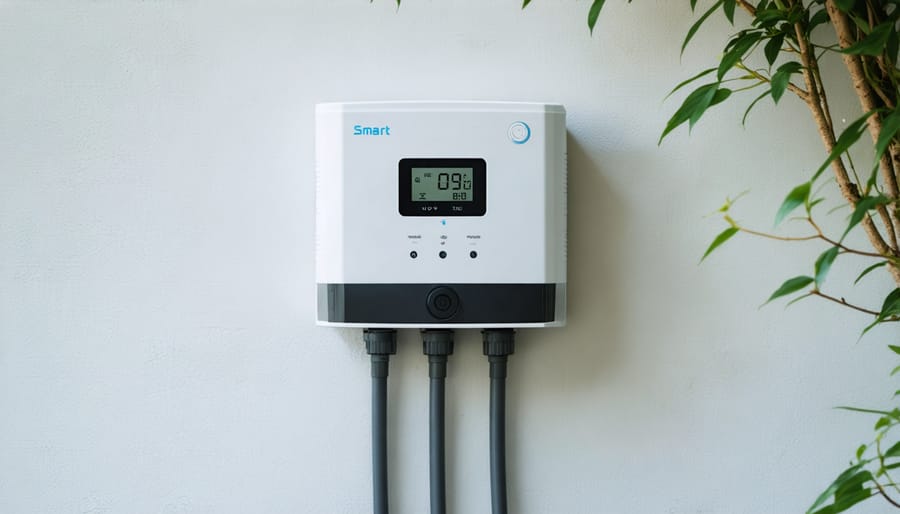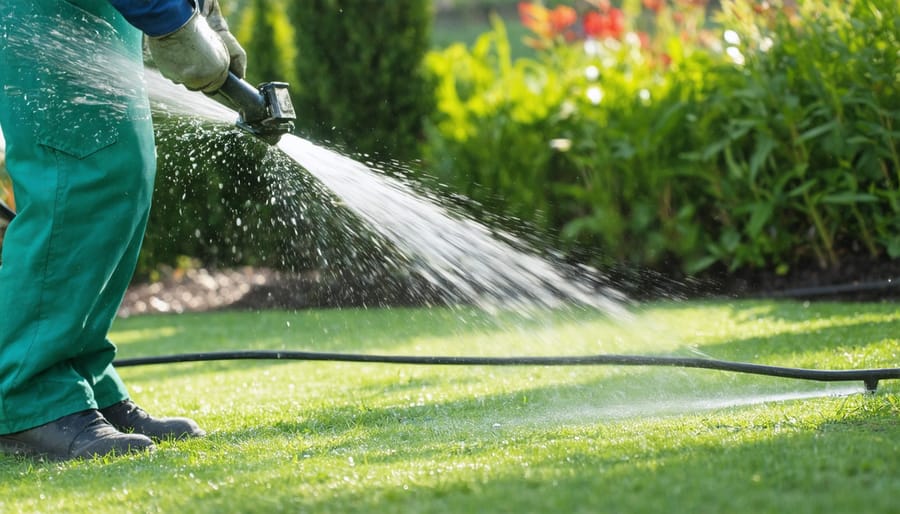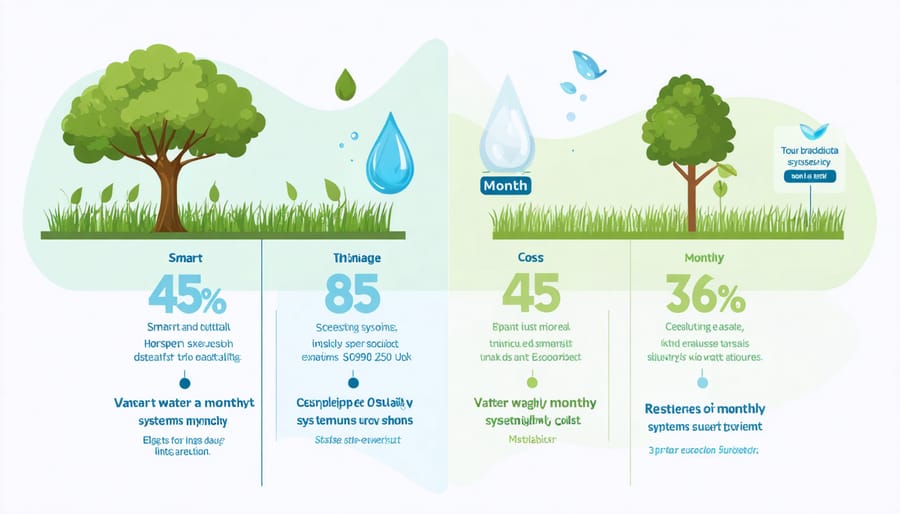Invest $2,000-$4,500 in a professional automatic irrigation system to boost your property value and slash water bills by up to 30% annually. Modern smart irrigation technology transforms basic sprinkler setups into intelligent water-management solutions that pay for themselves within 2-3 years. While DIY installation can cut initial costs to $1,500-$2,500, professional installation ensures optimal zone coverage, proper water pressure calibration, and seamless integration with existing landscaping. Factor in monthly water savings of $30-$50, reduced maintenance needs, and increased curb appeal when calculating the true cost of your irrigation investment. Beyond the upfront expense, consider the long-term value: automated systems typically last 10-15 years with proper maintenance, making them a smart financial decision for budget-conscious homeowners seeking both convenience and efficiency.
Basic Components and Their Costs
Control Units and Smart Controllers
The heart of your automatic irrigation system lies in its control unit, with prices varying significantly based on features and capabilities. Basic controllers start around $30-$50, offering simple timing functions and support for 4-6 zones. Mid-range controllers ($80-$150) provide more zones, multiple programs, and weather sensors for smarter watering decisions.
For the tech-savvy homeowner, smart irrigation control systems offer the most convenience and water-saving potential, typically ranging from $150-$300. These WiFi-enabled controllers allow you to manage your irrigation from your smartphone, automatically adjust to weather forecasts, and even integrate with your home automation system.
Consider your yard size and complexity when choosing a controller. While premium smart controllers cost more upfront, they can pay for themselves through reduced water bills and improved plant health. Budget-friendly options work well for smaller yards with simple watering needs, while larger properties benefit from advanced controllers with multiple zone support and sophisticated programming options.
Remember to factor in additional sensors ($20-$40 each) like rain and soil moisture sensors, which can enhance any controller’s efficiency regardless of price point.

Sprinklers and Drip Systems
Sprinkler systems come in various types, each with its own price point. Traditional pop-up sprinkler heads typically cost between $2 and $10 each, while more advanced rotary sprinklers range from $8 to $25 per unit. For larger areas, impact sprinklers offer good coverage at $10-$20 per head.
Drip irrigation components are generally more affordable upfront. Basic drip emitters cost around $0.50-$2 each, while soaker hoses run $10-$30 for a 50-foot length. Drip tubing typically costs $0.15-$0.30 per foot, making it an economical choice for garden beds and landscaping borders.
Smart sprinkler heads, which offer features like weather monitoring and smartphone control, are the priciest option at $30-$100 per unit. However, they can lead to significant water savings over time.
For a typical quarter-acre lot, you might need:
– 6-12 pop-up sprinklers ($12-$120)
– 50-100 drip emitters ($25-$200)
– 100-200 feet of drip tubing ($15-$60)
– Basic controller ($30-$100)
Pro tip: Consider mixing sprinkler types based on your landscape needs to optimize both coverage and cost.
Valves, Pipes, and Fittings
The plumbing components of your irrigation system typically account for 30-40% of your total material costs. PVC pipes, the most common choice, range from $0.50 to $2 per foot depending on diameter and quality. Control valves, essential for managing water flow, cost between $15 and $45 each. You’ll also need various fittings like elbows, tees, and couplings, which usually run $1-5 per piece.
A typical residential system requires 3-4 valves, 100-200 feet of pipe, and approximately 20-30 fittings. Budget around $200-400 for these basic components. For enhanced durability, consider upgrading to copper fittings or professional-grade PVC, though this can increase costs by 30-50%. Pro tip: Always buy extra fittings – they’re inexpensive and can save you frustrating trips to the hardware store during installation.
Installation Costs Explained

Professional Installation Pricing
Professional installation costs for automatic irrigation systems typically range from $2,500 to $6,500 for an average-sized yard, though prices can climb to $10,000 or more for larger properties with complex layouts. These costs include both labor and materials, with labor typically accounting for 50-60% of the total price.
Several key factors influence the final installation cost. Property size is the most significant factor, with contractors usually charging $500-$1,000 per zone. The type of soil and landscape features can affect labor costs, as rocky terrain or steep slopes require more time and effort to install. Your choice of sprinkler heads and control systems will also impact the total price, with smart controllers adding $200-$400 to the base cost.
Most professional installers charge between $50-$100 per hour for labor, with a typical installation taking 2-4 days to complete. This includes trenching, laying pipes, installing sprinkler heads, setting up the controller, and performing initial system tests. Many companies offer package deals that combine installation with annual maintenance plans, which can save money in the long run.
When getting quotes from professionals, make sure they include:
– Complete system design and layout
– All necessary permits and inspections
– Trenching and pipe installation
– Sprinkler head placement and adjustment
– Controller installation and programming
– System testing and owner orientation
– Warranty coverage
While professional installation costs more upfront than DIY, it often provides better long-term value through proper design, expert installation, and warranty protection. Most reputable companies also offer free consultations and detailed written estimates to help you understand exactly what you’re paying for.
DIY Installation Savings
Installing your irrigation system yourself can lead to substantial savings, with DIY installations typically costing 40-60% less than professional services. For a standard residential system, you might spend $1,500-$2,500 on materials compared to $3,500-$6,000 for professional installation. These savings make DIY smart garden installation an attractive option for budget-conscious homeowners.
The main cost advantages come from eliminating labor charges, which typically account for 50-65% of professional installation costs. You’ll only need to purchase materials like PVC pipes, sprinkler heads, valves, and a controller. Basic tools required for installation are relatively affordable, and many homeowners already own items like shovels, tape measures, and pipe cutters.
However, consider these factors before deciding to DIY:
– Time investment: Expect to spend 2-4 weekends completing the installation
– Physical effort: Involves digging trenches and laying pipe
– Learning curve: Understanding system design and local codes
– Equipment rental: You may need to rent a trencher ($75-150/day)
To maximize savings while ensuring quality:
– Create a detailed plan before purchasing materials
– Buy components during off-season sales
– Compare prices from multiple suppliers
– Consider purchasing a pre-designed kit
– Start with a smaller zone to build confidence
Remember that while DIY installation offers significant savings, proper planning and careful execution are essential for a successful outcome. Factor in your skill level and available time when making your decision.
System Size and Property Considerations
The size and layout of your property play a crucial role in determining the overall cost of your automatic irrigation system. Larger properties naturally require more sprinkler heads, longer pipe runs, and additional zones, which directly impacts the total cost.
For a small urban lot (under 4,000 square feet), you might need 4-6 zones and approximately 12-18 sprinkler heads, keeping costs relatively manageable. Medium-sized properties (4,000-10,000 square feet) typically require 6-12 zones and 20-40 sprinkler heads, while large properties over 10,000 square feet might need 12 or more zones with 40+ sprinkler heads.
Your property’s layout and features also affect the system’s complexity and cost. Irregular shapes, slopes, or multiple landscaping zones (like separate flower beds, vegetable gardens, and lawn areas) usually require more zones and specialized equipment. Each zone needs its own valve, which adds to the material costs.
Other property-specific factors that influence costs include:
– Soil type and composition (affecting trenching difficulty)
– Existing landscaping (working around mature trees and established gardens)
– Water pressure and source location
– Local climate conditions
– Accessibility for installation equipment
Smart planning can help optimize costs regardless of property size. Consider dividing your yard into hydrozones – grouping plants with similar water needs together. This approach not only reduces the number of necessary zones but also improves water efficiency and system performance.
Pro tip: Create a detailed property map marking existing features, plant types, and sun exposure patterns before planning your irrigation system. This helps identify potential challenges and allows for more accurate cost estimation. Remember that while a larger system costs more initially, the long-term benefits of proper irrigation often justify the investment through reduced water bills and healthier landscaping.
Long-term Costs and ROI
Monthly Operating Costs
Understanding your monthly operating costs is crucial when investing in automated garden maintenance systems. The two main expenses you’ll need to consider are water usage and electricity consumption.
For water costs, expect your monthly bill to increase by $10-30 during peak growing seasons, depending on your garden size and local water rates. However, smart irrigation systems typically use 30-50% less water than traditional watering methods, potentially saving you money in the long run. A well-programmed system will only water when necessary, adjusting for rainfall and seasonal changes.
Electricity costs are relatively minimal, averaging $2-5 per month for most residential systems. Modern controllers are energy-efficient, using about as much power as a 5-watt LED bulb. Smart controllers with WiFi capabilities might consume slightly more power but offer enhanced features that can lead to better water management.
To optimize costs, consider:
– Programming your system to run during early morning hours
– Installing a rain sensor to prevent unnecessary watering
– Regular maintenance to catch leaks early
– Seasonal adjustments to water schedules
– Using drip irrigation in plant beds for maximum efficiency
Keep in mind that these costs can vary based on your climate zone, local utility rates, and system complexity. Many homeowners find that the monthly operating costs are offset by water savings and healthier plant growth.

Maintenance and Repairs
Regular maintenance of your automatic irrigation system typically costs between $75 and $200 per year, depending on your system’s complexity and local service rates. This usually includes essential tasks like spring start-up, winterization, and periodic system checks to ensure everything runs smoothly.
Common repair expenses you might encounter include replacing broken sprinkler heads ($2-$15 each), fixing leaky valves ($20-$40), or addressing controller issues ($50-$200). While these costs might seem concerning, remember that preventive maintenance can help avoid more expensive repairs down the line.
To keep maintenance costs manageable, consider performing simple tasks yourself, such as:
– Cleaning sprinkler heads monthly
– Checking for leaks and water pressure issues
– Adjusting sprinkler coverage seasonally
– Monitoring your water bill for unusual spikes
Professional services are recommended for more complex issues like:
– Pipe repairs ($50-$250)
– Valve replacement ($125-$300)
– Control system troubleshooting ($75-$150 per hour)
– Major system overhauls ($500+)
Keep in mind that newer systems generally require less maintenance and are more energy-efficient. While the initial investment might be higher, modern irrigation systems often pay for themselves through reduced repair costs and water savings over time. Setting aside about $150-$300 annually for maintenance and potential repairs is a good rule of thumb for most homeowners.
Investing in an automatic irrigation system is a significant decision that can enhance your property’s value and simplify your lawn care routine. While initial costs typically range from $1,500 to $5,000, the long-term benefits often justify the investment through water savings, improved lawn health, and reduced maintenance time.
For budget-conscious homeowners, starting with a basic DIY system can keep costs under $1,000, with the flexibility to upgrade components over time. Professional installation, though pricier, ensures proper setup and often includes warranties that protect your investment. Remember that factors like yard size, system complexity, and local climate will influence your final costs.
To make the most cost-effective choice, consider starting with a simple system in high-priority areas and expanding later. Look for smart controllers and moisture sensors that optimize water usage, as these features typically pay for themselves through reduced water bills. Don’t forget to factor in annual maintenance costs of $75-150 to protect your investment.
Whether you choose DIY installation or professional service, proper planning is crucial. Get multiple quotes, research local water regulations, and consider seasonal demands before making your decision. With careful consideration of these factors and regular maintenance, your automatic irrigation system can provide reliable, efficient lawn care for years to come while maintaining a healthy balance between upfront costs and long-term value.